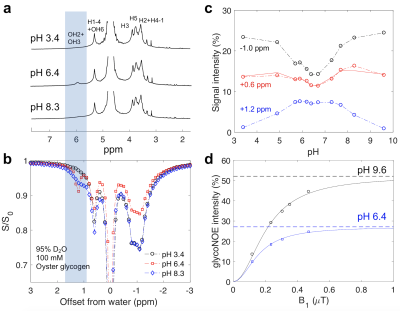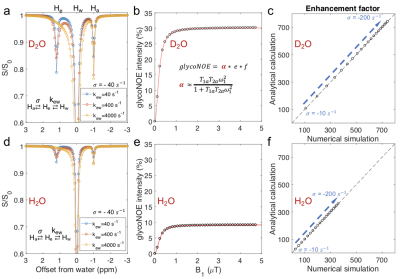Yang Zhou1, Peter van Zijl2,3, Jiadi Xu2,3, and Nirbhay N. Yadav2,3
1Institute of Biomedical and Health Engineering, Shenzhen Institutes of Advanced Technology, Shenzhen, China, 2The Russell H. Morgan Department of Radiology, The Johns Hopkins University School of Medicine, Baltimore, MD, United States, 3F.M. Kirby Research Center for Functional Brain Imaging, Kennedy Krieger Institute, Baltimore, MD, United States
1Institute of Biomedical and Health Engineering, Shenzhen Institutes of Advanced Technology, Shenzhen, China, 2The Russell H. Morgan Department of Radiology, The Johns Hopkins University School of Medicine, Baltimore, MD, United States, 3F.M. Kirby Research Center for Functional Brain Imaging, Kennedy Krieger Institute, Baltimore, MD, United States
The analytical solution for rNOE based magnetization transfer in CEST experiments is derived and then successfully validated for polycarbohydrates through both numerical simulations and experimental data from glycogen in different solvents and as a function of pH.

Figure 1. The pH dependence of NMR and Z-spectral intensities for oyster glycogen (100 mM glucose units) in 95% D2O/5% H2O. (a) 1D NMR spectra at different pH. (b) Z-spectra at three pH values (4s continuous RF irradiation, B1 = 0.4 µT). (c) Lorentzian fitted peak intensities (S/S0) at +1.2, +0.6 and -1.0 ppm as a function of pH. (d) GlycoNOE (-1 ppm) intensity as a function of B1 (16s continuous RF) at two pH values. The curve was fitted using Eq. 1.

Figure 2. Numerical simulations agree with the analytical results. (a, d) Numerically simulated Z-spectra for different hydroxyl exchange rates. (b, d) The dependence of the numerically simulated glycoNOE (black circles) intensities on B1 field strengthis in agreement with that using the analytical solution (red line, using Eq. 1). (c, f) Values for the enhancement factor (e) for numerically and analytically simulated data are the same.